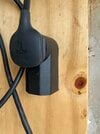Hi, was wondering if anyone else have been experience the same thing I have. It started sometime this year where my home charging, using a 220v outlet with 50 Amp double breaker, goes from 32 amp to 16. All connections are solid and the plugged to the wall is not hot. Not sure why that is. It's been charging fine from March 2019 til the end of 2021.
Breaker doesn't trip or anything, it just drops amperage while charging. If I unplug the charge (at the car) and replug, it goes back up to 32, therefore, I believe it's the car and not the amperage coming to the car from the house.
Thoughts?
Thanks
Breaker doesn't trip or anything, it just drops amperage while charging. If I unplug the charge (at the car) and replug, it goes back up to 32, therefore, I believe it's the car and not the amperage coming to the car from the house.
Thoughts?
Thanks



